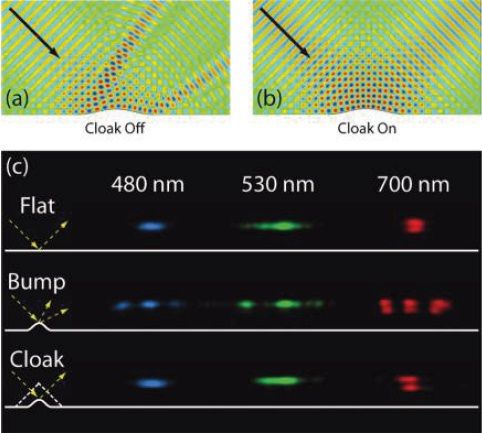
© Majid Gharghi, et al./American Chemical SocietyWhen an input beam (black arrow) reflects off (a) a bump without a cloak, the bump causes a perturbation. When the beam reflects off (b) a bump covered by a cloak, the cloak masks the bump, and the reflected beam is reconstructed as if the bump did not exist. (c) Light after reflection from a flat mirror, a bump without a cloak, and a cloaked bump, at three different wavelengths.
Most of the invisibility cloaks that have been demonstrated to date conceal objects at frequencies that are not detectable by the human eye. Designing invisibility cloaks that can conceal objects from visible light has been more challenging due to the strict material requirements. But in a new study, researchers have fabricated a carpet cloak that can make objects undetectable in the full visible spectrum.
The researchers, led by Prof. Xiang Zhang at the University of California, Berkeley, and Lawrence Berkeley National Laboratory, have published their study in a recent issue of
Nano Letters.
As the researchers explain, most previous invisibility cloaks have used metallic metamaterials for cloaking at microwave frequencies. But at optical frequencies, the metal absorbs too much light and leads to significant metallic loss, and Berkeley and other groups have had to design dielectric cloaks at infrared frequencies. More recently, researchers at University of Birmingham (UK) have experimented with using uniaxial crystals as the cloak material, which can enable cloaking in visible frequencies, but only for a certain polarization of light.
In the current study, the researchers used a technique called quasi conformal mapping (QCM) to conceal an object with a height of 300 nm and a width of 6 µm underneath a reflective "carpet cloak." The carpet itself has the appearance of a smooth optical mirror, so that the object and the bump that the object makes underneath the carpet are undetectable by visible light.
